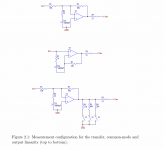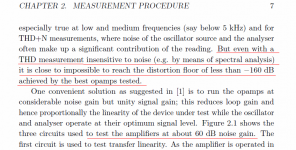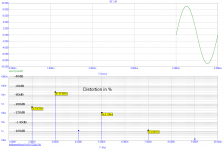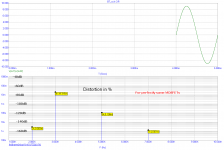When I am simulating BT, for balanced input and balanced output I get this at 9Vp output amplitude. It is good, but if for John any 7th at any level (like -160dB) is an evil, he will find it even here. And, the simulation assumes perfectly matched JFET parts. 1st simulation is for some difference in output MOSFET capacitances, 2nd for absolutely same parts.
If the AD797 was measured under normal conditions (and NOT with 1000x distortion magnification as Grooner does), I am sure it would not be worse in 7th and it would be MUCH better in 2nd and 3rd.
Anyway, the level of 7th like this is absolutely unimportant, regardless BT or AD797.
If the AD797 was measured under normal conditions (and NOT with 1000x distortion magnification as Grooner does), I am sure it would not be worse in 7th and it would be MUCH better in 2nd and 3rd.
Anyway, the level of 7th like this is absolutely unimportant, regardless BT or AD797.
Attachments
Last edited:
I think we are talking about analog integrated circuits in a very strange and abstract way, here. I don't even now what is the purpose and why this focus on this old AD797.
An asymmetrical line driver after a potentiometer able to be driven in DC ?
A symmetrical line driver for 600 ohms professional use ?
An active filter ?
An amplifier after a passive bass/treble corrector ?
A low noise one to be part of a moving magnet RIAA P.U. preamplifier ?
A DAC buffer ?
A DC servo ?
I suppose i would chose a different device for each of those needs, and, may-be two for some of those purposes.
An asymmetrical line driver after a potentiometer able to be driven in DC ?
A symmetrical line driver for 600 ohms professional use ?
An active filter ?
An amplifier after a passive bass/treble corrector ?
A low noise one to be part of a moving magnet RIAA P.U. preamplifier ?
A DAC buffer ?
A DC servo ?
I suppose i would chose a different device for each of those needs, and, may-be two for some of those purposes.
Last edited:
Thanks PMA for your frank criticism, and your measurements. NOW, I have something to work with, but please understand: I use my CTC balanced out with 1V rms max per side, because I have a voltage gain of 27.2 following it to match THX specs. Most of the time I am below 0.1V per side, as 0.1V would give 90+ dB in my living room, and I live in a small apartment, with sensitive neighbors.
OF COURSE, if you push any design high enough, then 7th harmonic distortion will appear. However, it falls off very rapidly, according to a predictable mathematical equation so that it is almost nothing at any PRACTICAL working level. There is the problem of measuring it at working levels, Better to find 7th at a much higher level and scale down to working levels, mathematically.
OF COURSE, if you push any design high enough, then 7th harmonic distortion will appear. However, it falls off very rapidly, according to a predictable mathematical equation so that it is almost nothing at any PRACTICAL working level. There is the problem of measuring it at working levels, Better to find 7th at a much higher level and scale down to working levels, mathematically.
Now just to make this clear: The Blowtorch is rated for 3V out, balanced. It is not perfect here, but at this output, a Parasound amp following it will be clipping at over 1000W in my living room. See the problem? It is absurd then to worry about its operation, even its 7th harmonic above 3V.
Of course the construction of the Blowtorch is not perfect, nothing is, and it will have more measured distortion from less than ideal components that it is made of, as well. Best they each don't contribute too much, however.
Let's get real. 7th harmonic is something to avoid. A super linear transfer function is one of the best ways to minimize it at ALL working frequencies. Feedback can help too to reduce measured distortion, but it has other problems, so I use it to a minimum, when I can.
Of course the construction of the Blowtorch is not perfect, nothing is, and it will have more measured distortion from less than ideal components that it is made of, as well. Best they each don't contribute too much, however.
Let's get real. 7th harmonic is something to avoid. A super linear transfer function is one of the best ways to minimize it at ALL working frequencies. Feedback can help too to reduce measured distortion, but it has other problems, so I use it to a minimum, when I can.
Now just to make this clear: The Blowtorch is rated for 3V out, balanced. It is not perfect here, but at this output, a Parasound amp following it will be clipping at over 1000W in my living room. See the problem? It is absurd then to worry about its operation, even its 7th harmonic above 3V.
OK, fine. So at that level and with that load (which I agree is absolutely reasonable), is the 7th (or 9th) of an IC based preamp significant? I restrict this question to modern ICs, not stuff from 1968.
Is the AD797 the opamp to beat? Sounds like a very good test to try. I will see if any AD797's are laying about.
Please use the circuits on the datasheet, and please lets compare same load resistance I have not seen to many PA's with 600 Ohms across the input.
EDIT - Thanks PMA, I knew that SG had some explanitory text to put this in context.
Last edited:
OK, fine. So at that level and with that load (which I agree is absolutely reasonable), is the 7th (or 9th) of an IC based preamp significant? I restrict this question to modern ICs, not stuff from 1968.
NO!!
NO!!
John said very explicitly that it is, and that it's this supposed defect which relegates IC-based preamps to "mid-fi," unsuitable for discerning ears. I await either his supporting data or his "oops, I was mistaken, thanks for the correction."
http://us.123rf.com/400wm/400/400/d...e-sur-plaques-isolees-sur-blanc-en-studio.jpgI don't do CD's. '-)
Last edited:
SACD is not a CD ? You like to play on words, or what ?SACD's or better, for me. '-)
Jan, just got Vol. 3, thanks.
The correct orthography is SA-CD and means Super Audio... CD.
Last edited:
rhetorical, much?
no they're DVD with funny servo track coding for anti-piracy, 4x the bit rate of RedBook CD
with the additional fun of being single bit DSD - basically a "noise modulated" ~ MHz carrier >+ 6 dB re audio fs
the only way to get the 120 dB noise spec at 20 kHz is to use >5th order negative feedback in the noise shaping process
so of course it is considered "more analog sounding" - wasn't that easy to predict from the tech details?
SACD is not a CD ? You like to play on words, or what ?
The correct orthography is SA-CD and means Super Audio... CD.
no they're DVD with funny servo track coding for anti-piracy, 4x the bit rate of RedBook CD
with the additional fun of being single bit DSD - basically a "noise modulated" ~ MHz carrier >+ 6 dB re audio fs
the only way to get the 120 dB noise spec at 20 kHz is to use >5th order negative feedback in the noise shaping process
so of course it is considered "more analog sounding" - wasn't that easy to predict from the tech details?
Last edited:
cool idea dept -
Take a wide band, high slew rate amplifier - implying low-med nfb circuit - and add a comparator to the I/O and feed the comparator output back into an amplifier input to cancel remaining distortion. Works very well, it seems from data shown. Some old guy from France named Christophe showed this in another DIYAudio forum. Very cool, IMO. Thx, RNMarsh
Take a wide band, high slew rate amplifier - implying low-med nfb circuit - and add a comparator to the I/O and feed the comparator output back into an amplifier input to cancel remaining distortion. Works very well, it seems from data shown. Some old guy from France named Christophe showed this in another DIYAudio forum. Very cool, IMO. Thx, RNMarsh
Last edited:
- Status
- Not open for further replies.
- Home
- Member Areas
- The Lounge
- John Curl's Blowtorch preamplifier part II



